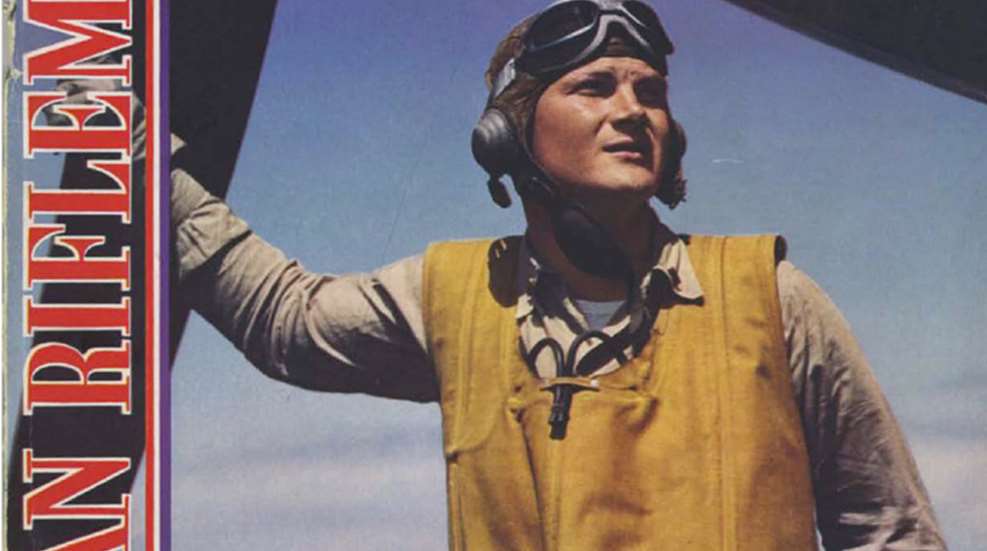
This article was first published in May 1943, American Rifleman.
By Lt. Stuart D. Ludlum, USNR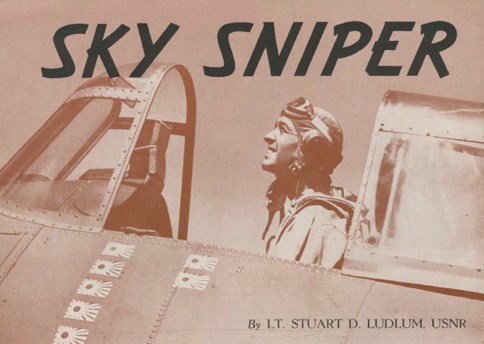
"Don’t shoot at the quail... Shoot where he's going to be when the shot gets there." Though the shotgun's recoil rattled his teeth and rocked him on his heels. Little Jimmy Thach learned to swing smoothly and to shoot without flinching. He learned lead and follow through so that he could put a single .22 bullet out in front "where the rabbit
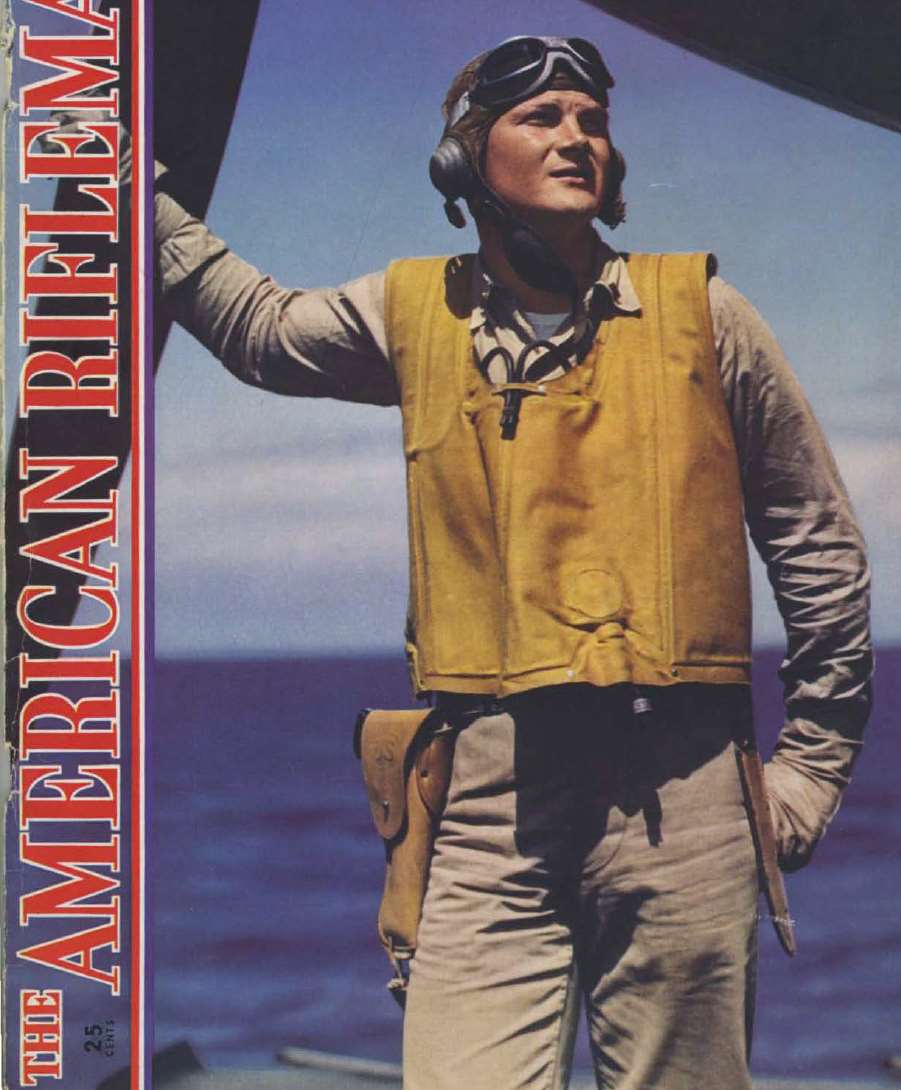
is going to be" and send it rolling into a pie pan. Whether wing shooting or depending on one slug to do the work of 2 hatful, Jim Thach put a premium on marksmanship.
Six Grumman Wildcats roar off the flight deck, wheel into the sky and climb like express elevators. Lt. Commander John Smith (Jim) Thach, now Skipper of Fighter Three, and his wingman spot a Jap four engine patrol plane. He starts his run. It's like the last rapid fire string in the National Match Course ... only the target's shooting back. Smooth speed ... rhythm ... every maneuver sheer velvet ... no jerking ... no flinching. Working together in perfect coordination, his hands and feet line up his ringsight on the target and then move it out front. The "pipper" (the dot in the middle of the ringsight) is leading perfectly. He presses the trigger and breaks away. A few brief seconds and the smoking Jap plunges into the sea.
Minutes later, another two-plane section, led by Lt. O. B. Stanley, shoots down another patrol bomber.
Toward mid-afternoon, enemy planes are reported. Two more fighter patrols hop off the carrier into the sky to intercept.
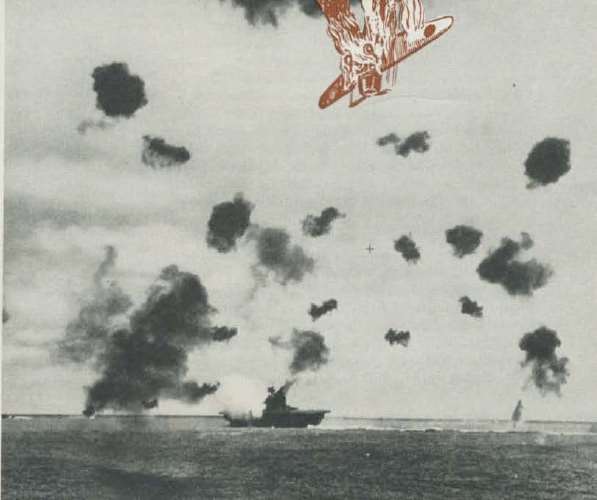
Here's the chance Fighter Three has been waiting for ... Has Jimmy taught them well? Are his sky-shooting skills sound? These airborne marksmen have never been in combat before .... They believe in Jimmy Thatch and his shooting ideals, but, after all, they're only ideas…
At 1630 (Navy for 4:30 p.m.) nine Mitsubishi bombers streak for the carrier. This is it! All those hours of attacks, and runs, and marksmanship practice are now to be put to the test. The flying shooters of Fighter Three—like well-trained riflemen in their first visit to Camp Perry—following the detailed instructions of their coach, resisting the excitement that could easily upset their technique—smoothly swing their three-ton flying guns into position. They press the triggers. Five Jap bombers crash into the sea. The other four release their bombs far from their target, miss it by nearly two miles, and head hell-bent for home. One is blasted by the anti-aircraft sharpshooters on the carrier. Three are given "the treatment" and are confirmed. ... One gets away.
A second flight of Jap bombers is detected coming in from the east. Only two fighters are in position to intercept. They pile into the nine bombers and in the next few minutes one of the great fights of all time takes place. It's history now, but there are angles for those who are interested in skillful marksmanship.
The guns of one plane jam. He has to leave and quick. The other makes his approach, and many things race through his mind. Very little ammunition for such a big covey. A bomber takes a lot of shooting to put it out ... you got to hit it where it hurts ... deep in the heart of the X-ring. And you can't take too many chances when you are the last man between the bandits and the carrier .... If they sink the carrier, where you going to land? Ever think of that? So you've got to make every shot count without "expending" yourself.
Judge your range ... their speed ... start your run … bank smoothly ... everything's got to be done smoothly ... can't black yourself out with a fast or jerky turn and expect to hold and squeeze. Lead just right. ... Press! Smoke and flames say, "Pinwheel", and now the next one! Working from back to front of the Vee, the pipper lines up just where it ought to be ... press ... smoke ... flames ... crazy spin into the sea. Next!! Climb for another run ... a short burst this time .... Break away ... Next!
" ... Without hesitation, alone and unaided, he repeatedly attacked this enemy formation at close range in the face of their intense combined machine gun and cannon fire, and ... by his gallant and courageous action,his extremely skillful marksmanship, making the most of every shot of his limited amount of ammunition, shot down fire enemy bombers and severely damaged a sixth before they reached the bomb release point ... "
So reads the citation that went with Butch O'Hare's Congressional Medal of Honor. Courage, shooting skill ... and sky sniping marksmanship, drilled into him by Jimmy Thach, made O'Hare one of the world's most skillful flying fighters.
By the time those two patrols of Fighter Three were back on deck, Jim Thach's theories had become a proven formula for sky killing with fixed guns.
When the score was tallied at the end of the day, the Japs had lost nineteen out of twenty bombers sent into combat. That twentieth would have been a dead pigeon if they could have followed it a little longer. But a single-seated fighter doesn't carry gasoline and ammunition enough to chase the last bully home after cleaning up on the rest of his gang.
We lost two fighter planes and one pilot.
Fighter Three won its first brush with the Japs in the cornfields of Arkansas ... on the rifle ranges and the hardwood ridges of the Mid-West. Uncle Sam owes a lot to the man who taught his son to shoot where his target is going to be and not where it is when you pull the trigger, Jim Thach's dad did a lot more than give his son a taste for outdoor life … instill in him a love for guns... and the thrill of hunting. He taught him to respect and aspire to kill in marksmanship.
Born in Fordyce, Arkansas, in April, 1905, John Smith Thach entered the Naval Academy in 1923. After graduation in 1927—and a few weeks of flight instruction to find out if he took to the air—he was ordered to the fleet for a tour of duty. He learned fleet operations and this knowledge served him well in his later air battles. For when he was fighting his squadron high above the ships,he knew pretty well what they were trying to do below.
In 1929 he was ordered to Pensacola for flight training, and his enthusiasm went into "high" when it came to aerial gunnery. He hadn't lost his love for cracking moving targets, and here it was at its best, shooting a flying target with a flying gun.
When a student officer is learning to fly, he wants those wings more than anything else on earth or in the air. But once he wins them and is attached to a fighter squadron, he wants a little painted "E" on his plane. This is the badge of an expert aerial marksman. Once Jim was out with the Fleet as a Naval Aviator, it didn't take him long to win his "E". He soon found that he couldn't flinch a plane and hit his X-ring any more than he could hit it when he flinched with a rifle. On the other hand, when he swung smoothly, led and followed through, his scores mounted.
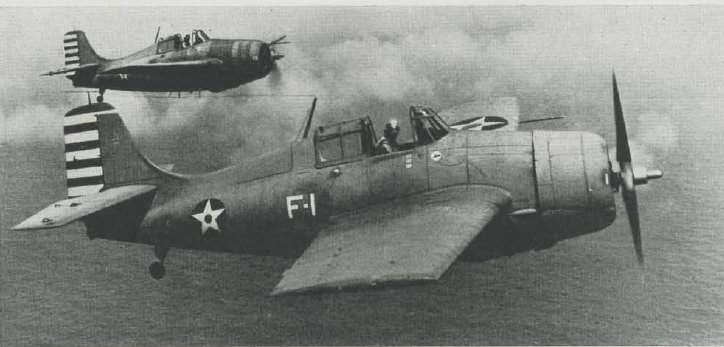
After various aviation assignments with fighter allied patrol squadrons, Jim found himself Gunnery Officer of Fighter Three ... which immediately won the Championship of the Fleet in Marksmanship. A year before Pearl Harbor, Jim was made Skipper of the squadron, and even though his men were the shooting champs, he was dissatisfied.
He wanted more time for training. He was developing fighting tactics that were based on sound shooting techniques. He believed that a flier who couldn't shoot would be just as useless to a fighting squadron as a shooter who couldn't fly. He, himself, was expert in both and was working out a way to coordinate them (to blend them with team flying) and to come out with a fighting formula that was 4-0, which in the Navy is perfection.
Everything seemed to conspire against him, however. "Bugs" arose in the planes and they were grounded. When they were rarin' to go, the carrier was diverted to ferrying Army bombers to the islands of the Pacific. In June, 1941, he did get thirty days at Pearl Harbor with his squadron, and those thirty days, Saturdays and Sundays included, were spent in the air, shooting. They got results.
Even before Fighter Three proved the effectiveness of Jim's methods by killing Japs wholesale, the Navy began to take notice. He received a letter of commendation for excellence in gunnery operations in 1939-1940: "For exceptional skill and technique in aerial gunnery and bombing, efficient and meticulous operation of the squadron gunnery department; marked ability to train other pilots in fighting plane tactics and gunnery." It was encouraging that the Navy recognized and appreciated the need for fliers who could shoot. In his Navy Cross and Distinguished Service Medal citations, his skill as a marksman is emphasized: " ... Through his courage and skill he shot down one enemy bomber and, with the assistance of his teammates, shot down a second bomber."
" ... Pursuing till.' bold and fearless tactics of a great lighter and skillful airman, Lieutenant Commander Thach led a division of his squadron on a mission providing protection for our own attacking torpedo squadron. Facing intense antiaircraft fire, the squadron under his command efficiently attacked an overwhelming number of enemy Japanese fighters, shooting down three of them."
A fighter plane is a super-accurate automatic pistol. It shoots with fixed guns. The air pressure against the wings, at speeds between 300 and 400 miles an hour, holds the guns and gives machine rest steadiness. Like a pistol compared with a long arm, it's highly maneuverable.
You can aim it with one hand. Like the .41 Automatic, its bullets are the punchy kind. A burst of concentrated fire from a Grumman Wildcat's "fifties" has a most satisfactory way of messing things up—for the enemy—like slugging a clip of forty-fives into a can of tomatoes—before point rationing.
If you load a fighting plane down with extra ammunition or fuel, armament or armor, or other equipment, it's like hanging a big magazine or a heavy sight ramp or curvaceous grips on a handgun. It loses its ability to gain altitude advantage quickly just as the pistol loses its quick-draw, fast -pointing attributes. Fortunately, the United States Navy has long recognized the principles of fighter combat and has given our fighter squadrons some mighty handy flying guns that have proven themselves highly effective in a devastating sort of way.
The seven Jap flags, painted on Jim Thach's plane, are convincing proof that he has acquired the knack of knocking Japs out of the sky. But his skills are more far reaching, for he possesses qualities of leadership and the ability to teach. He has taught his fighter combat tactics to other Navy squadrons and is now supervising the making of training films at the Walt Disney studios and at the Navy’s gigantic training center in Jacksonville.
These films are being used to make lethal marksmen out of the thousands of pilots the Navy is training every year. In any kind of shooting it is hard to say how much skill is due to inherent ability and how much to teaching. O'Hare was a good rifle shot before he learned to fly. But he and the other pilots of VF-3 (Fighting Squadron Three) give most credit to Thach's shooting tactics.
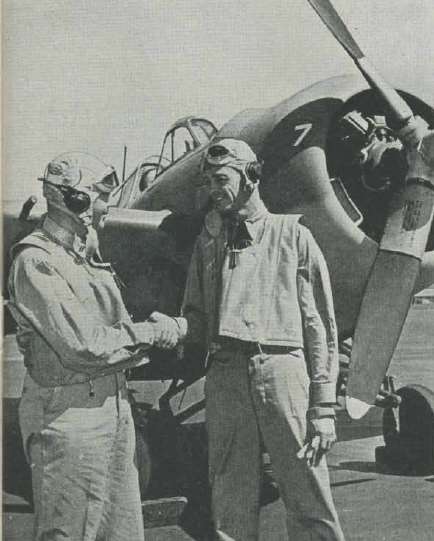
Lieutenant Noel Gayler was another one of Thach's sky snipers who did his Skipper proud. Thach likes to tell about the time they escorted dive and torpedo bombers over the unexplored mountains of New Guinea, one of the most hazardous flights in Naval aviation. As they pulled their heavy planes up into the thin air around the tops of these amazingly high peaks, it looked as though they just weren't going to make it. They began to lose altitude at the rate of 600 feet a minute. Their Skipper,however, soon found a green flat area. He led his planes over it, caught the warm updrafts he was hoping to find there and rode them over the passes with less than ten feet to spare. That's not very much leeway when you're sitting on top of a ton torpedo that has plenty of whang in its warhead.
When they finally did get over and were pummeling ships and land installations at Lac and Salamaua, Gayler was on his way down in a strafing dive when, out of the corner of his eye, he spotted a Jap seaplane, He nosed up just long enough to center a burst and send the Jap down in flames. Then he continued his dive. This was a rather deft bit of snap-shooting.
Another time a Zero was trying to tease Gayler into a trap. Zeros are very light and can climb faster than 4000 feet a minute. They try to get you to follow them up.If you do, they climb out of your range, roll over when you arc far below and come tobogganing back at you when you're hanging on your prop, a "duck soup" target.
But Gayler wasn't tricked. He anticipated the pull-up and gave the Jap a burst just as he began to climb. He didn't. He burned instead. Gayler pulled another "quick draw" when II swarm of Zeros had him ducking in and out of a cloud. Every time he poked his nose out, they were waiting for him.
Back in he went.
"I came out one side'," he explains, "and saw a Jappie below me. He saw me and made that instinctive pull-up right in front of my guns. I let him have burst. He burned, too."
On the way back to his carrier Gayler shot down two more Zeros. Just to clear his guns before landing. These two brought his total to eight clean kills. Every marksman in America, every shooter who knows the future of our country depends on our ability to shoot straight as individuals—whether we have in our hands a six pound sub-machine gun or a ten thousand pound flying automatic—will find in the wording of Jim Thach's Distinguished Service Medal citation, Official America's awakening to the priceless value of shooting "know how".
"For exceptionally meritorious service to the Government of the United States as Commander of a carrier Fighting Squadron during the first six months of the war. The remarkable quality of leadership displayed by Lieutenant Commander Thach was exemplified in the through and comprehensive training of his pilots in both their brilliant combat tactics and excellent gunnery. The resultant high state of combat efficiency attained by his squadron enabled it to play a decisive and major part in the destruction of nineteen of the twenty enemy Japanese bombers which attacked an aircraft carrier on February 20, 1942. And to make an essential contribution to the success of the air attack on Salumaua and Lae. New Guinea on March 10, 1942. The effectiveness of his unique system of fighting plane combat teams, evolved from a detailed study of action reports of the Coral Sea Battle and taught not only to his pilots but to all of the fighting squadrons in the Hawaiian area, was demonstrated north of Midway Island on June 4, 1942. In this engagement, Lieutenant Commander Thach led a four plane division of fighter planes from his squadron against twenty enemy Zero fighters during the successful attacks by our carrier-based planes against enemy fighters and destroyed six enemy fighters and repulsed the others with the loss of only one of his four planes."





































